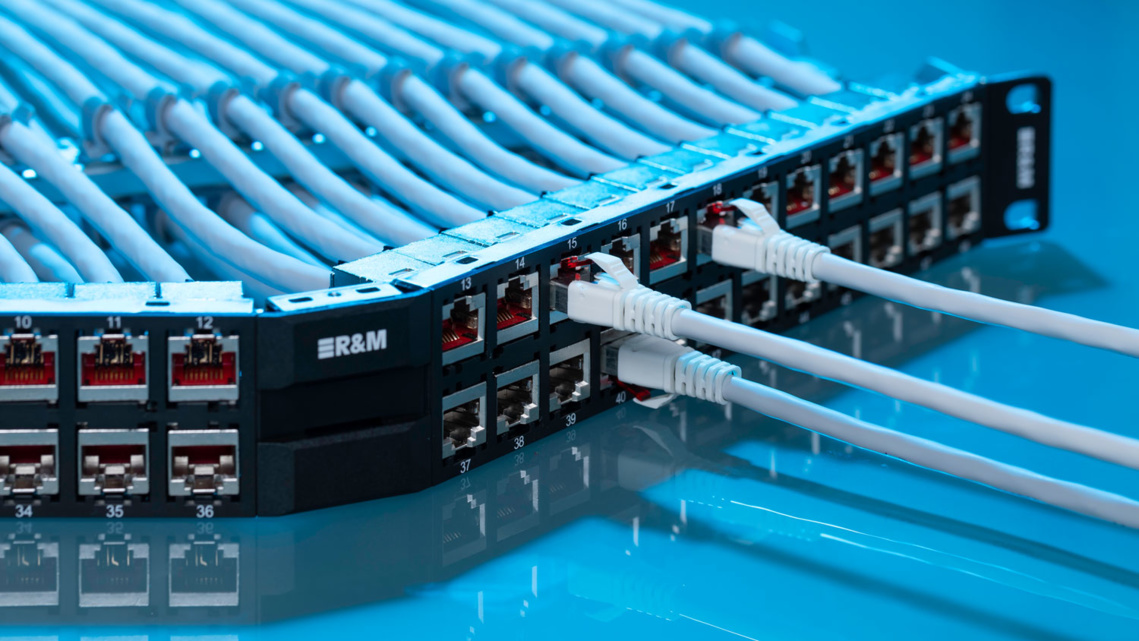This year, 2020, is providing us with numerous trend-setting insights. Due to the pandemic, millions of people suddenly had to start working from home. If private internet access provides sufficient performance, this can actually be quite productive and useful. But it is often the case that there is not sufficient performance. A lot of people working at home complain about slow internet connections.
Even in metropolises, the provision of broadband is seen as being insufficient. This is how ISP review reported on the findings of a survey of 1,500 inhabitants of the British capital in August 2020 where 71.3% of Londoners were upset by the absence of broadband connections at home and 82% said that broadband is one of the most important utility services for them today.
Fibre to Home is rising
According to an analysis by Research and Markets, the global market of Fiber to the Home/Building (FTTH/FTTB) is currently growing at a rate of 13.9% per annum. The number of FTTH customers in Europe is rising 15% a year according to the FTTH Council Europe. European telecom operators are accelerating network expansion and intensifying their commitment to more bandwidth. Their offers with data rates of more than 100 Mbit/s have a market share of 29.6%.
Telecom operators, application and content providers have come a long way in building relationships with each other in recent years. Yet the next major investment in broadband networks will demand even more: The future of broadband infrastructure depends on further collaboration between application and content providers and telecom operators, and a deeper understanding of how they interplay to each other’s benefit.
The last decade illustrates how a mixture of innovation in broadband communications and IT can rapidly reshape how society communicates, works and entertains. But we are on the brink of much greater change. Ongoing innovation in the fields of nanotechnology, biotechnology and computing promise to radically alter the way we use, design and distribute goods, health care, education, entertainment and communication services.
Content-based World
After all, few people building power stations in the early 20th century could have imagined the extent to which electricity networks would drive new industries for domestic appliances and revolutionize housework. Fortunately, the creators of yesterday’s power generators laid an infrastructure that could accommodate a century of growth.
Today’s investors in broadband need to take a similar leap and create a sustainable, flexible infrastructure that can accommodate new, unexpected services and ways of doing business. In this article, we will look at how very high-speed FTTH access is needed for innovative and diverse services and create the potential for new businesses and mutually beneficial interaction between diverse sectors.
Back to the Future
Internet history reveals a strong correlation between how much bandwidth consumers have at their disposal and the development of content, service and device ecosystems. Whole new communication and business models have been made possible by increases in broadband access speeds. Back in 1996, CEOs from major software companies, including Oracle, put forward the idea of network computing, which is the storing and running of applications on a server in a network. The idea was great, but dial-up Internet speeds were not.
The concept of network computing was shelved. Fast forward over a decade and the accessing and sharing of resources on servers in a network or cloud computing is becoming a reality for users equipped with very high-speed broadband. Striking changes in communications usage have also taken place in the home. Over a decade ago, receiving a phone call when online usually resulted in a dropped connection
Consumers today would baulk at such levels of service. Instead, their requirements are growing in line with the simultaneous use of several residential broadband applications. And there is every sign that consumers’ demands will grow, with the next stage in delivering content and interactive video broadband services requiring more capacity than today’s legacy networks can provide. If service providers are to avoid their customers cancelling their subscription and going to the competition, then they will need to invest in infrastructure that can cope with huge capacity requirements from both fixed and wireless usage.
Wireless network speeds
People have also benefited when on the move. Clever marketing and design helped put smartphones where they are today and a mini mobile computer would be much less practical without the last decade’s constant rise in wireless network speeds.
But mobile operators cannot squeeze capacity from their networks, indefinitely: continuing growth in mobile data usage places constraints on wireless networks, which need to be alleviated by local fibre access networks. Not only does fibre provide backhaul from base stations Wifi, 3G and 4G can also be integrated with an FTTH installation to provide full wireless coverage throughout the home.
In this way consumers can connect several wireless devices running HD or 3D video via Wifi to the FTTH network, allowing mobile operators to lift the strain on their mobile infrastructure and offer a sophisticated array of broadband services. FTTH takes residential users far beyond simple triple-play and opens the door to the concurrent use of multiple high-bandwidth applications.
Home Networking
FTTH allows operators to enrich their triple-play offerings today while laying the foundations for the entertainment and home management network of the future. The ongoing moves to develop e-education, e-health and e-administration services, combined with the increasingly intelligent home devices creates new business opportunities for telecom operators, energy companies, electrical goods and device manufacturers, broadcasters, film distributors and content and application service providers. To date, telcos have collaborated fruitfully with content providers on video-on-demand and television services, as digital downloads become an increasingly important channel for film distributors.
The market for transactional movies growing year-on-year, with digital rental increasingly becoming consumers’ favored way of consuming films, according to the film and broadcasting research company, Screen Digest. FTTH will serve to strengthen the relationships between the producers of video content and network operators and provide the bandwidth capacity to investigate new business models.
Service providers, for example, will be able to offer 3D video-on-demand and television programming, or semi-immersive online gaming. In addition, FTTH’s large upload capacity opens up the potential to offer new low-latency, high-quality video services, alongside home management and surveillance services, as well as e-health and e-education.
Workplace revolution
Of course, the transformational effects of broadband reach far beyond an individual’s personal sphere. Today’s broadband infrastructure already enables individuals to connect and do business with a global network of companies, from home or the office. The resulting flexibility in working practices benefits employers, employees and contractors alike. Yet the next step-change in how companies and workers collaborate will require FTTH.
Very high-speed fibre broadband, for example, lets companies and individuals use shared cloud computing resources to remotely access heavy-duty enterprise applications. This not only further facilitates working from home, it also opens new ways for knowledge workers around the world to interact with large companies and each other. Cloud computing also creates cost-effective methods of sharing huge computational resources for research and development projects, regardless of where participants are based.
Many application, telecom and service companies have already developed cloud computing applications. In addition, FTTH will give companies of all sizes the means to use secure, private, high-quality video conferencing facilities. As a result employees and contractors will be able to communicate with multiple parties in various locations around the world. Again, no one company holds all the pieces that will create the new working environment of tomorrow. Telcos, however, have built strong reputations for providing enterprise-strength applications making them well-placed to collaborate on offering the next generation of secure remote enterprise services.
Transforming healthcare
Security and reliability will be the key to another important role for FTTH, this time in the distribution of health services. Governments’ faced with ageing populations are looking for cost-effective ways to use IT and telecom networks to provide care and monitoring to the growing numbers of the chronically sick and elderly. This shift means private companies, including telecom operators, software firms, health equipment suppliers and insurance companies, are working with health authorities to create e-health applications that greatly improve efficiency without dehumanizing, or reducing the quality of patient care.
Low latency high-quality video-conferencing, for example, allows patients to interact directly with caregivers, doctors and nurses, without having to undertake long journeys. FTTH will allow HD quality video-conferencing, regardless of whether others in the home are using online applications. A telepresence-like HD video connection not only maintains the caregiver-patient relationship, it offers key visual clues of a patient’s state of health. Such services are of particular benefit when patients may be far from specialist care.
But video services are also of use to patients who prefer to return home to recover from medical intervention, yet still, need to consult face to face with their doctor. And as e-health services evolve, FTTH’s almost unlimited capacity can allow for an increasingly sophisticated video exchange between a patient at home and multiple health service providers, in addition to an exchange of patient data.
Video-conference
In addition, hospitals, which are already equipped with fibre networks, will be able to quickly share huge files, such as scans with general practitioners equipped with FTTH, while discussing a patient’s diagnosis via a video-conference. E-health applications mean working adults suffering from chronic diseases such as diabetes, can conduct check-ups online, rather than taking precious time off work to wait for consultations in doctors’ surgeries or hospitals
Other video-based health care applications include physical rehabilitation systems that run over high-speed broadband, which allow patients to practice movements while imaging sensors pick up any mistakes.
Telecom operators equipped with both FTTH and a trusted consumer brand are well placed to partner with health service providers and insurance companies to deliver health services. Video exchange brings health benefits that are less direct, but important nonetheless. Elderly tech-savvy baby-boomers will be able to use HD or even 3D video conferencing and other communication tools that enable a real-time experience when keeping in touch with each other and their families. The independence that a very high-speed broadband infrastructure offers means elderly people could stay longer in their own homes, particularly when the benefits of video social networking are bolstered by personal, professional health care.
It is Time for Change
Consumers and businesses the world over have been quick to view any new broadband capacity as an essential part of their social and economic fabric. Cloud-based services and the internet of things i.e. the communication between billions of sensors, which enable new and exciting applications, will accelerate broadband adoption.
But the broadband adoption is not only fast and massive, it is also addictive. 84 percent of Germans in their 20s would rather give up their car or partner than their broadband connection; 41 percent of UK internet users would rather keep Internet connection than TV. And consumers are not about to become less dependent on broadband. The social network revolution has re-shaped consumer broadband behavior; today’s emerging generation of broadband users manage and conduct their social life around online connections.
The next big changes will be in the online distribution of health, education and energy services, as well as the development of smart cities. Today’s increasing richness of new applications and its value for our way of living puts the power to shape future broadband usage in the hands of consumers, rather than telecom operators. Today’s networks need to be ready for rapid change. And operators and other stakeholders need to prepare for a future that is not just about providing telecom services but building an engine for socio-economic development.





